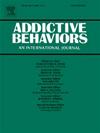吸食尼古丁的青少年使用大麻的情况
IF 3.7
2区 医学
Q1 PSYCHOLOGY, CLINICAL
引用次数: 0
摘要
背景青少年使用电子烟仍然是一个公共卫生问题,许多青少年希望戒烟。然而,吸食大麻在使用电子烟的青少年中很常见,这可能会干扰戒除尼古丁的努力。本研究旨在调查吸食尼古丁并有戒烟动机的青少年使用大麻的情况。方法康涅狄格州的青少年(人数=223,年龄=17.3 [SD=1.7]岁)完成了一项吸食尼古丁戒烟研究的调查,报告了他们吸食尼古丁的情况、使用的大麻产品、使用的原因、使用的频率以及戒除大麻的准备情况。描述了人群的特征。结果 大多数人报告了大麻使用情况(终生:92.4%;上月:68.6%)。吸食和吸食大麻的比例很高(吸食:终生-90.8%,当前-63.6%;吸食:终生-90.8%,当前-63.1%)。大多数人报告说,与其他吸食途径相比,他们更喜欢吸食大麻(58.7%)。吸食大麻的常见原因包括精神作用(如兴奋)、身体作用(如改善睡眠)和社交作用(如聚会)。大麻使用频率和更喜欢吸食大麻(与其他方式相比)与更频繁地吸食尼古丁呈正相关(ps < 0.05)。在戒除吸食尼古丁寻求帮助的青少年中,通过多种途径吸食大麻的现象很普遍。大麻和尼古丁的大量使用似乎是相关的,这给那些寻求戒除吸食尼古丁的人带来了减少危害的挑战。了解大麻和尼古丁的共同使用对于针对使用这两种物质的治疗非常重要。本文章由计算机程序翻译,如有差异,请以英文原文为准。
Use of cannabis among youth who vape nicotine
Background
Youth e-cigarette use remains a public health concern and many youth want to quit. However, cannabis use is common among youth who use e-cigarettes, which may interfere with nicotine cessation efforts. This study aimed to investigate cannabis use among youth who vape nicotine and are motivated to quit nicotine.
Methods
Connecticut youth (N=223, Mage = 17.3 [SD=1.7] years) who completed an intake for a vaping cessation study reported on their nicotine vaping, cannabis products used, reasons for use, frequency of use, and readiness to quit cannabis. Descriptives characterized population. Regressions were used to examine association of cannabis use and nicotine vaping.
Results
Most reported cannabis use (lifetime: 92.4 %; past-month: 68.6 %). Cannabis smoking and vaping were highly prevalent (smoking: lifetime − 90.8 %, current − 63.6 %; vaping: lifetime − 90.8 %, current − 63.1 %). Most reported preferring smoking cannabis (58.7 %) over other routes of administration. Common reasons for cannabis use, were psychoactive (e.g., getting high), physical (e.g., improving sleep), and social (e.g., partying). Cannabis use frequency and preferring smoking cannabis (vs. other modes) was positively associated with more frequent nicotine vaping (ps < 0.05). Participants averaged 6.3 (of 10) on a readiness to quit cannabis scale, a moderate desire to quit.
Conclusions
Cannabis use across multiple routes of administration was common among youth seeking help quitting vaping nicotine. Heaviness of cannabis and nicotine use appear to be associated, raising interesting harm-reduction challenges for those seeking to quit nicotine vaping. Understanding cannabis and nicotine co-use is important for targeting treatment for use of both substances.
求助全文
通过发布文献求助,成功后即可免费获取论文全文。
去求助
来源期刊

Addictive behaviors
医学-药物滥用
CiteScore
8.40
自引率
4.50%
发文量
283
审稿时长
46 days
期刊介绍:
Addictive Behaviors is an international peer-reviewed journal publishing high quality human research on addictive behaviors and disorders since 1975. The journal accepts submissions of full-length papers and short communications on substance-related addictions such as the abuse of alcohol, drugs and nicotine, and behavioral addictions involving gambling and technology. We primarily publish behavioral and psychosocial research but our articles span the fields of psychology, sociology, psychiatry, epidemiology, social policy, medicine, pharmacology and neuroscience. While theoretical orientations are diverse, the emphasis of the journal is primarily empirical. That is, sound experimental design combined with valid, reliable assessment and evaluation procedures are a requisite for acceptance. However, innovative and empirically oriented case studies that might encourage new lines of inquiry are accepted as well. Studies that clearly contribute to current knowledge of etiology, prevention, social policy or treatment are given priority. Scholarly commentaries on topical issues, systematic reviews, and mini reviews are encouraged. We especially welcome multimedia papers that incorporate video or audio components to better display methodology or findings.
Studies can also be submitted to Addictive Behaviors? companion title, the open access journal Addictive Behaviors Reports, which has a particular interest in ''non-traditional'', innovative and empirically-oriented research such as negative/null data papers, replication studies, case reports on novel treatments, and cross-cultural research.
 求助内容:
求助内容: 应助结果提醒方式:
应助结果提醒方式:


